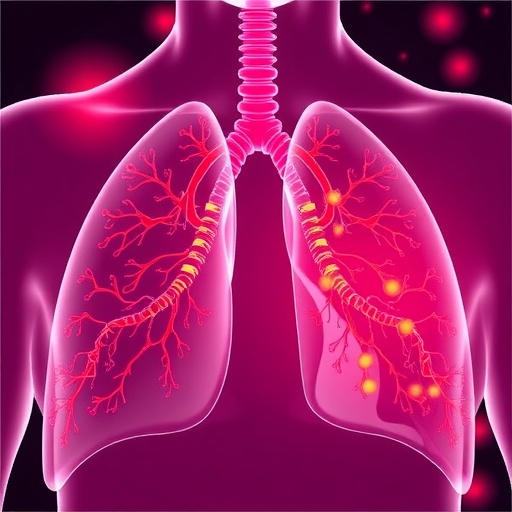In a groundbreaking meta-analysis published in BMC Cancer, researchers have shed new light on the evolving radiotherapy paradigms for treating locally advanced non-small cell lung cancer (LA-NSCLC), emphasizing innovations that could dramatically alter clinical outcomes. The study meticulously compares high-dose-rate (HDR) brachytherapy, stereotactic body radiotherapy (SBRT), and hypofractionated proton therapy—three cutting-edge modalities within the domain of low linear energy transfer (LET) irradiation. This comprehensive review scrutinizes survival rates, tumor control, and toxicity profiles to elucidate optimal therapeutic strategies for patients deemed ineligible for surgical intervention.
Locally advanced non-small cell lung cancer represents a significant clinical challenge, given its aggressive nature and limited treatment options for patients unsuitable for surgery. Traditional radiotherapy approaches have relied on low-LET hypofractionated regimens, yet their relative efficacy and safety require ongoing evaluation as novel technologies emerge. The present meta-analysis distills insights from eight rigorously selected studies encompassing nearly 500 patients treated between 2005 and 2019, providing one of the most extensive comparative assessments of these innovative radiotherapeutic techniques to date.
Central to this investigation is high-dose-rate brachytherapy, a modality that delivers intense radiation from within the tumor itself, thereby maximizing dose precision and sparing adjacent healthy tissues. The analysis reveals that HDR brachytherapy confers notable advantages in overall survival (OS), with a median OS reaching 38 months. Remarkably, the two-year OS rate with this modality stands at 68%, significantly surpassing the 54% and 56% figures observed for SBRT and proton therapy, respectively. These statistics underscore HDR brachytherapy’s potential to redefine therapeutic benchmarks in LA-NSCLC management.
Local control (LC) of primary tumors is another critical metric underscored in the study. HDR brachytherapy exhibits a two-year local control rate exceeding 87%, outperforming SBRT’s reported 75% and approaching proton therapy’s 84%. This improved tumor targeting precipitates a reduction in residual or recurrent disease, a factor tightly linked to enhanced survival outcomes. The superior dosimetric precision of HDR brachytherapy, enabling escalated biologically effective doses directly within the tumor microenvironment, is likely responsible for these encouraging data.
Biologically effective dose (BED) calculations provide a crucial quantitative framework for comparing radiotherapy schedules. The research delineates a clear survival advantage when BED_10, a reference parameter, reaches or exceeds 78 Gy. Patients receiving these higher BEDs exhibit a two-year survival rate of 62%, compared to merely 38% for those below this threshold. This finding highlights the importance of optimizing dosage regimens to surpass therapeutic thresholds necessary for effective tumor eradication while balancing normal tissue tolerance.
Toxicity profiles remain a paramount consideration in radiotherapy, dictating patient quality of life and long-term complications. HDR brachytherapy demonstrates a remarkably low incidence of acute toxicities, ranging from 0 to 10%, and notably, no grade 3 or higher late toxicities were observed. Conversely, SBRT was associated with acute toxicity rates between 8% and 16%, and proton therapy presented rare but significant late toxicities above grade 3 in 14% of cases. These disparities emphasize HDR brachytherapy’s safety and tolerability, encouraging its integration into treatment protocols.
The dynamic interplay between radiation dose, fractionation schedules, and LET characteristics defines the therapeutic window for radiotherapy. Low-LET radiation modalities, including the strategies evaluated here, induce DNA damage predominantly through indirect free radical mechanisms, offering distinct radiobiological advantages and challenges. Innovations in hypofractionation—delivering larger doses per treatment fraction over fewer sessions—promise enhanced patient convenience and resource efficiency while necessitating robust safety assessments, as conducted in this review.
Clinically, the meta-analysis bolsters HDR brachytherapy’s standing as a potent, safe alternative to conventional external beam radiotherapy approaches. The integration of these findings into multidisciplinary oncology practice could sharpen patient selection criteria and personalize radiotherapy plans. Moreover, the study’s emphasis on dose escalation through BED optimization dovetails with emerging trends in radiation oncology aimed at maximizing tumor cytotoxicity while preserving normal tissue integrity.
The heterogeneity of LA-NSCLC presents inherent complexities in treatment; thus, the comparative approach adopted here is particularly valuable. By synthesizing data across different radiotherapy modalities and encompassing a substantial patient population, the study offers clinicians evidence-based guidance that transcends individual institutional experiences. This can foster standardized practices while stimulating innovation in radiation delivery technologies and techniques.
From a technological perspective, advancements in imaging, real-time dosimetry, and treatment planning have enabled HDR brachytherapy and SBRT to achieve unprecedented spatial accuracy. Proton therapy’s unique physical properties, including the Bragg peak phenomenon, facilitate maximal dose deposition in tumors while sparing surrounding healthy tissues, albeit with variable toxicity profiles as highlighted. These complementary modalities collectively expand the radiation oncologist’s armamentarium against LA-NSCLC.
Importantly, this systematic review and meta-analysis serve not only as an evaluative tool but also as a hypothesis-generating platform. The compelling survival and toxicity outcomes associated with HDR brachytherapy call for further prospective clinical trials to validate these observations and to explore synergistic combinations with systemic therapies, such as immunotherapy and targeted agents. The evolving landscape of lung cancer treatment underscores the need for multi-modal, personalized approaches.
Furthermore, the study underlines the vital role of biologically effective dose thresholds in guiding dose-fractionation decisions. The identification of 78 Gy as a critical BED_10 value for improving overall survival provides a quantifiable target for clinicians designing radiation therapy regimens. This dose-response relationship aligns with radiobiological principles and reaffirms the significance of precision dosing in maximizing therapeutic efficacy.
The assessment of toxicity events across treatment modalities provides reassurance regarding the long-term safety of advanced radiotherapy techniques. Reducing acute and late toxicities translates into tangible patient benefits, including preserved pulmonary function and reduced risk of radiation pneumonitis or fibrosis. Such outcomes are particularly relevant for patients with compromised respiratory reserves, common in this population.
In sum, this extensive meta-analysis revisits and refines the paradigm of radiotherapy for LA-NSCLC ineligible for surgery, illuminating the promising role of HDR brachytherapy alongside SBRT and proton therapy. The demonstrated superiority in survival and local tumor control, allied with favorable toxicity profiles, propel HDR brachytherapy toward greater prominence in clinical practice. Moreover, reaffirming the importance of biologically effective dose thresholds provides a roadmap for optimizing existing and future radiotherapy regimes.
As lung cancer remains a leading cause of cancer mortality worldwide, innovations that improve therapeutic indices without compromising safety are urgently needed. This study’s findings not only enrich the academic discourse but also hold transformative potential for patient care, fostering hope for improved outcomes through precision radiotherapy. Future research spearheaded by these insights will likely alter standards and herald a new era in the multidisciplinary management of LA-NSCLC.
—
Subject of Research: Innovations and comparative evaluations of low linear energy transfer radiotherapy modalities—high-dose-rate brachytherapy, stereotactic body radiotherapy, and hypofractionated proton therapy—in the treatment of locally advanced non-small cell lung cancer.
Article Title: Innovations in modern low-LET radiotherapy regimens for locally advanced non-small cell lung cancer: a meta-analysis and systematic review of high-dose-rate brachytherapy, stereotactic body radiotherapy, and hypofractionated proton therapy.
Article References:
Tan, M., Li, L., Tan, B. et al. Innovations in modern low-LET radiotherapy regimens for locally advanced non-small cell lung cancer: a meta-analysis and systematic review of high-dose-rate brachytherapy, stereotactic body radiotherapy, and hypofractionated proton therapy.
BMC Cancer 25, 942 (2025). https://doi.org/10.1186/s12885-025-14328-0
Image Credits: Scienmag.com
DOI: https://doi.org/10.1186/s12885-025-14328-0
Tags: advances in radiotherapy for lung cancerclinical outcomes in lung cancer radiotherapycomparative assessment of cancer therapieshigh-dose-rate brachytherapy benefitshypofractionated proton therapy reviewinnovative cancer treatment modalitieslocally advanced non-small cell lung cancer treatmentlow linear energy transfer irradiationmeta-analysis of radiotherapy techniquespatient eligibility for surgical interventionradiation therapy toxicity profilesstereotactic body radiotherapy effectiveness





